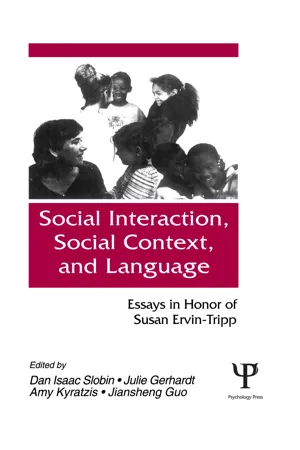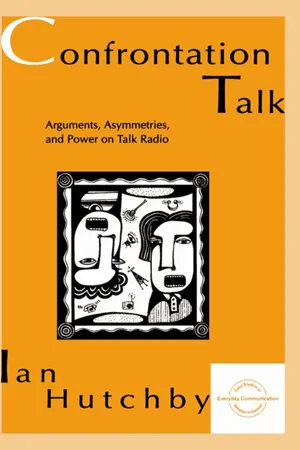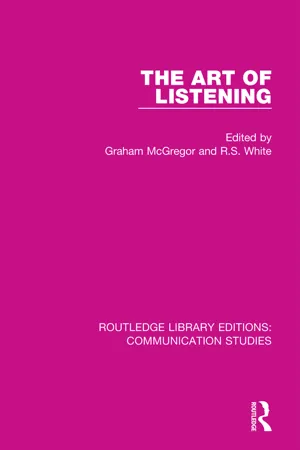Interruption
Interruption in linguistics refers to the phenomenon where one speaker interrupts another during a conversation. This can occur for various reasons, such as to assert dominance, show agreement, or express enthusiasm. Interruptions can impact the flow and dynamics of a conversation, and are often studied in sociolinguistics to understand the social and cultural implications of language use.
3 Key excerpts on "Interruption"
- eBook - ePub
Social interaction, Social Context, and Language
Essays in Honor of Susan Ervin-tripp
- Dan Isaac Slobin, Julie Gerhardt, Amy Kyratzis, Jiansheng Guo, Dan Isaac Slobin, Julie Gerhardt, Amy Kyratzis, Jiansheng Guo(Authors)
- 2014(Publication Date)
- Psychology Press(Publisher)
...There are also methodological problems, for instance, inadequate quantitative comparisons. Most of the studies reviewed by James and Clarke (1993) compared raw counts of Interruptions without taking speaking time into account. But raw counts can obviously be misleading unless men and women contribute equally to the interaction. The nine studies in the review that did use a measure that corrected for speaking time did not find any gender differences in mixed-gender dyads or groups. With this paper we want to contribute to the theoretical and methodological discussion in this field with a small experimental study of same- and mixed-gender interactions of well-acquainted adult professionals. The gap between observational and experimental studies can, in our view, only be bridged by having nonstudent speakers participate in our experiments and observing the same kinds of speakers in genuine interactions. Simultaneous speech, Interruptions, and dominance Interruptions occur when one speaker begins to talk while another is speaking. As straightforward as this common-sense definition of Interruptions may sound, it does not cover all and only such behavior that we would intuitively classify as interruptive. An interrupter may cut in while the current speaker is pausing and thus not, strictly speaking, talking. Vice versa, listener feedback like mhm, uhuh, or yes is often produced while the speaker is still talking; yet it is obviously not interruptive. These examples suggest that a useful definition of Interruptions should include functional criteria relating to the interactional effect of interruptive behavior. Many recent studies of Interruption behavior implicitly or explicitly apply such functional criteria. Listeners' back-channel contributions that do not, and clearly are not intended to, disrupt the speech flow, are usually excluded from the category of Interruptions...
- eBook - ePub
Confrontation Talk
Arguments, Asymmetries, and Power on Talk Radio
- Ian Hutchby(Author)
- 2013(Publication Date)
- Routledge(Publisher)
...Thus there is both a sequential and a moral dimension to Interruption: Interruptions are violative on the level of turn-taking conventions and on the level of interpersonal relations. Therefore, it would seem that Interruption is by definition not only an incursive act, but also an intrusive, even hostile one. However, this is not quite the case. As Goldberg (1990) observes, speakers who produce utterances that on the purely sequential level interrupt another’s speech may, on the interactional level, be doing either affiliative or disaffiliative actions. Goldberg distinguishes between Interruptions that are “power” displays and those which display “rapport” by concentrating on what appear to be the motivations of their producers: “Given the multifunctional nature of Interruptions, the analyst must be able to distinguish between those Interruptions seemingly motivated by the interactional rights and obligations of the moment, and those seemingly produced to satisfy personal or interactional wants or needs” (p. 885). Goldberg pays less attention to another dimension of this distinction, however, namely the different ways in which interruptees may react to being interrupted, thereby displaying their orientation to the affiliative or disaffiliative nature of the action. This distinction can be illustrated in the following way. One way that Interruption may be responded to is by the current speaker rebuking the other for having made an illegitimate bid for the floor...
- eBook - ePub
- R. S. White(Author)
- 2015(Publication Date)
- Routledge(Publisher)
...308). A similar approach to speech production nay be found in Framkin (1973 and 1981). Most of the miscanmunications examined here are between people frail different dialect backgrounds: that is people whose internal grammars are different in sane specifiable way. This limitation is important methodologically as it helps us to assess the role of specifically Iinquistic knowledge in comprehension, and it seems likely that conclusions on this wider matter can be extended to communications between people with the same- dialect background. Although it may be seen as a contribution to a major theoretical issue, this chapter is primarily intended as an exercise in applied sociolinguistics; the insights of socio linguistics are used to analyse the manner in which oannunicative breakdown occurs between speakers in everyday situations and the consequences of this breakdown are considered. These two issues, the theoretical and the applied, will be considered in parallel throughout the discussion. A iti5ccmmunication may be said to take place when there is a mismatch between the speaker's intention and the hearer's interpretation. When two persons do communicate successfully, it is clear that much more is involved than the mapping of internal structures {or linguistic rules) on to external sequences, or conversely (from the listener's point of view), mapping external sequences on to internal structures (Bever, 1970, p. 286). A nuitber of perceptual strategies or 'shortcuts' appear to be implemented by a listener in decoding utterances, and it is probably most sensible to adopt for the moment Aitchison's notion of a person's grammar as a 'linguistic archive', available and ready for consultation in interpreting utterances, but not necessarily consulted...


